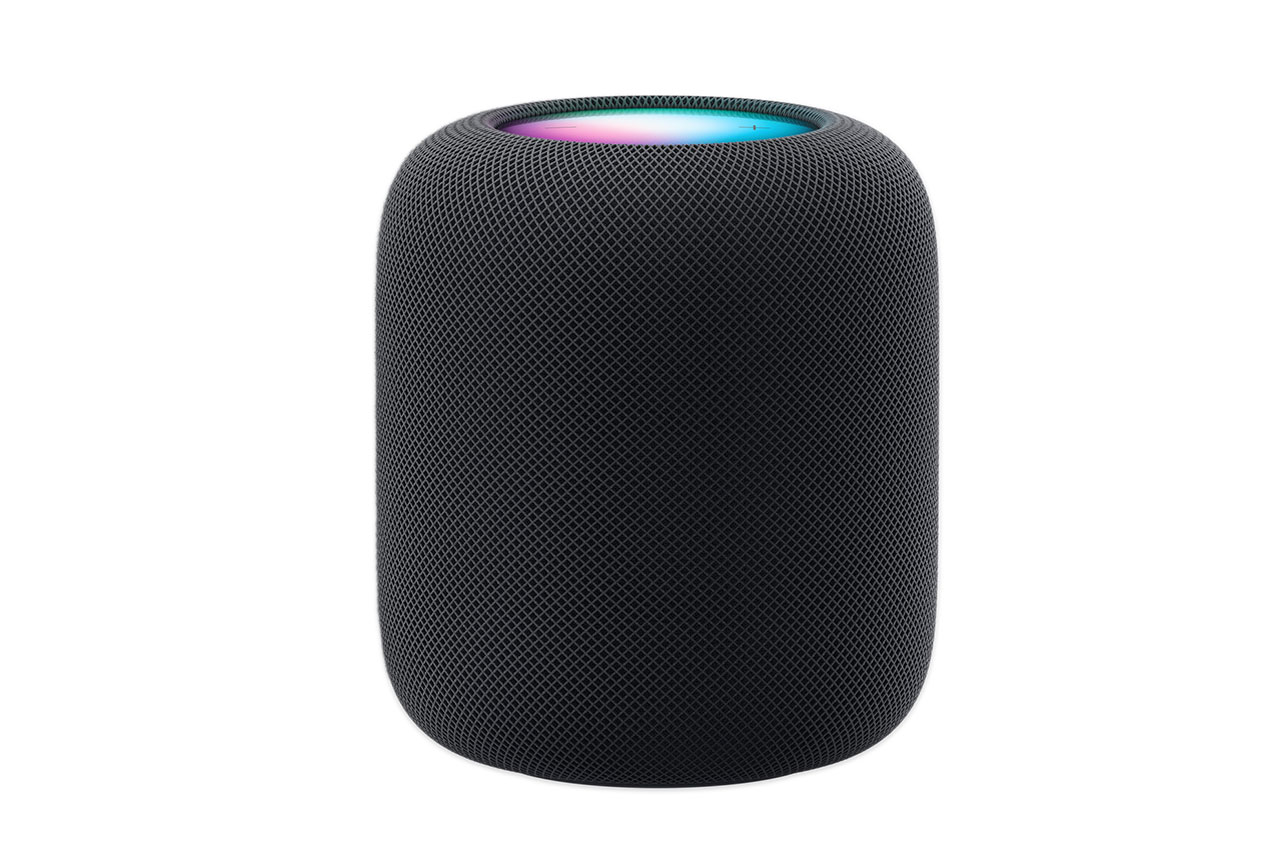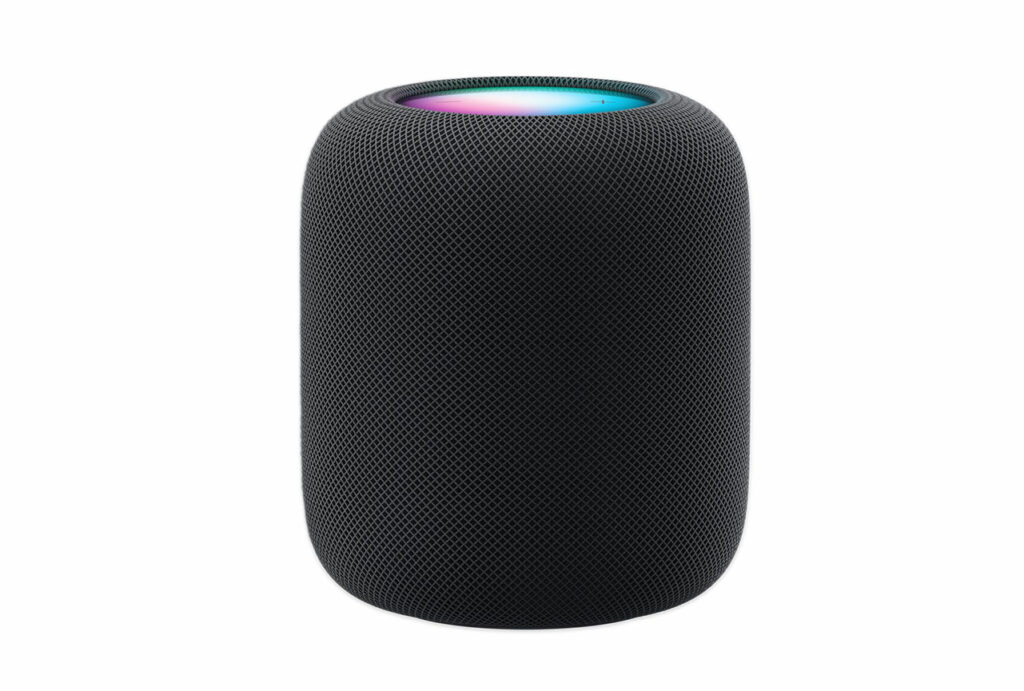We put the Apple HomePod (2nd Gen) through our rigorous DXOMARK Audio test suite to measure its performance at playing back audio. In this review, we will break down how it fared in a variety of tests and several common use cases.
Overview
Key specifications include:
- Wireless protocols: AirPlay
- Wired connectivity: None
- Height: 16.8cm, Width: 14.2cm, Depth: 14.2cm
- Weight: 2300.0 g
- Speakers: 4-inch high-excursion woofer, array of five horn-loaded tweeters, each tweeter with its own neodymium magnet
Test conditions:
- Tested with iPhone WSPK
- Communication protocol used: AirPlay
 Apple HomePod (2nd Gen)
Apple HomePod (2nd Gen)


Pros
- 360° sound rendition as advertised
- Strong bass
- Very consistent volume step distribution
Cons
- Inconsistent and aggressive treble, very weak midrange
- Poor dynamics performance
- 360° directivity aside, not much to offer in terms of spatial performance
The second generation of Apple’s HomePod made very few improvements over its predecessor. The speaker scored points with its strong bass and consistent 360° sound rendition, but it fell short in many other test categories. For example, treble sounded aggressive, and the overall tonal balance left room for improvement, with a very weak midrange. Dynamic performance was poor as well, with our experts particularly noticing a lack of punch.
Listen to the tested speaker’s playback performance in this comparison with its competitors:
Test summary
About DXOMARK Wireless Speaker tests: For scoring and analysis in our wireless speaker reviews, DXOMARK engineers perform a variety of objective tests and undertake more than 20 hours of perceptual evaluation under controlled lab conditions. This article highlights the most important results of our testing. Note that we evaluate playback using only the device’s built-in hardware. (For more details about our Speaker protocol, click here.)
The following section gathers key elements of our exhaustive tests and analyses performed in DXOMARK laboratories. Detailed performance evaluations under the form of reports are available upon request. Do not hesitate to contact us.
The DXOMARK Speaker overall score is derived from a range of sub-scores. In this section, we will take a closer look at timbre, dynamics, spatial, volume, and artifacts, and explain what they mean for the user.

Timbre
Apple HomePod (2nd Gen)
152
DXOMARK timbre tests measure how well a speaker reproduces sound across the audible tonal range and takes into account bass, midrange, treble, tonal balance, and volume dependency.
The HomePod (2nd Gen) delivered a timbre performance that was close to the first-generation model. While bass and treble were rendered strongly, there was a very noticeable lack of midrange. Treble was especially prominent at nominal volume, and, due to a lot of resonance, sounded slightly aggressive and almost piercing in most use cases, especially with musical content. When watching movies or listening to podcasts, the aggressive treble translated into sibilance and harshness. Treble could sound bright with the right content, but it never sounded rich in our tests.
These perceptual observations were confirmed by objective measurements, which showed resonances and notches. Midrange could be described as lackluster, sounding hollow. Our measurements showed a lack of information between 500Hz and 1500Hz, but resonance was also noticeable in the upper midrange. This might be down to the lack of a dedicated midrange speaker.
Bass was strong, with deep low-end extension. Particularly demanding content could make the bass sound “fake,” but in most use cases it did not sound boomy. Upper bass was slightly underwhelming as well, lacking information in some use cases, for example when watching movies. The 2nd Gen HomePod performed relatively well in reverberant room acoustics, thanks to its adaptive equalization. Bass did not become boomy in such conditions, but the “fake bass” effect and bass distortion became more and more intrusive at higher volumes. Treble resonances, on the other hand, reduced with increasing volume, making treble less aggressive. Midrange stayed lackluster, however, with a canny resonance in the upper midrange, even at maximum volume.
Tonal balance was identical across all angles, making for full 360° rendition.

Dynamics
Apple HomePod (2nd Gen)
137
Our dynamics tests measure how well a device reproduces the energy level of a sound source, taking into account attack, bass precision, and punch.
Dynamics performance was not one of the HomePod’s strengths. Attack was rendered poorly across all volume levels, sounding either crushed or rounded. The speaker also lacked bass precision as it often happens when bass is rendered “artificially.” The HomePod did not sound boomy, but its bass was blurry, as well as impaired by distortion and compression, especially at higher volumes. Punch was underwhelming too, lacking energy in the low midrange and upper bass.

Spatial
Apple HomePod (2nd Gen)
111
Our spatial tests measure a speaker’s ability to reproduce stereo sound in all directions, taking into account localizability, balance, wideness, distance, and directivity. Please note that wideness is 0 on mono speakers and on speakers that cannot deliver a significant stereo effect.
In our tests, the HomePod (2nd Gen) was almost perfectly omnidirectional, delivering consistent performance across all listening angles. This resulted in a good directivity score, and the speaker was able to deliver consistent results at various locations. However, the lack of stereophony (and thus wideness) is obviously a tradeoff, especially considering the emphasis on immersivity advertised on the official website. Localizability of individual sound sources was not great either. In addition, a weak midrange rendition and inconsistent treble did not allow for a realistic distance rendition of vocal content. Voices seemed both too far away (lack of midrange) and too close (sibilance) at the same time. As a result, not only did the HomePod fail to deliver the immersive experience that was promised in the marketing material, it also wasn’t able to convince our experts on other spatial-related aspects.

Volume
Apple HomePod (2nd Gen)
141
Our volume tests measure both the maximum loudness a speaker is able to produce and how smoothly volume increases and decreases based on user input.
In terms of loudness at the maximum volume setting, the HomePod (2nd Gen) slightly underperformed but was an improvement over the first-generation model. However, what it lacked in loudness it made up for in volume consistency, thanks to a very smooth volume steps curve.
Here are a few sound pressure levels (SPL) we measured when playing our sample recordings of hip-hop and classical music at maximum volume:
| Correlated Pink Noise | Uncorrelated Pink Noise | Hip-Hop | Classical | Latin | Asian Pop | |
| Apple HomePod (2nd Gen) | 79.8 dBA | 77.8 dBA | 78.4 dBA | 71.8 dBA | 79.5 dBA | 74.1 dBA |
| Harman Kardon Citation 200 | 86 dBA | 85.5 dBA | 83.1 dBA | 80.2 dBA | 84.1 dBA | 77.9 dBA |
| Sonos One | 85.6 dBA | 83.7 dBA | 79.5 dBA | 75.5 dBA | 81.8 dBA | 74.4 dBA |

Artifacts
Apple HomePod (2nd Gen)
133
Our artifacts tests measure how much source audio is distorted when played back, along with such other sound artifacts as noise, pumping effects, and clipping. Distortion and other artifacts can occur both because of sound processing and because of the quality of the speakers.
Overall handling of unwanted audio artifacts was average. Objective measurements showed a moderate amount of distortion. The speaker’s perceptual evaluation highlighted bass distortion and treble resonances, as well as some pumping at higher volume levels.



DXOMARK encourages its readers to share comments on the articles. To read or post comments, Disqus cookies are required. Change your Cookies Preferences and read more about our Comment Policy.